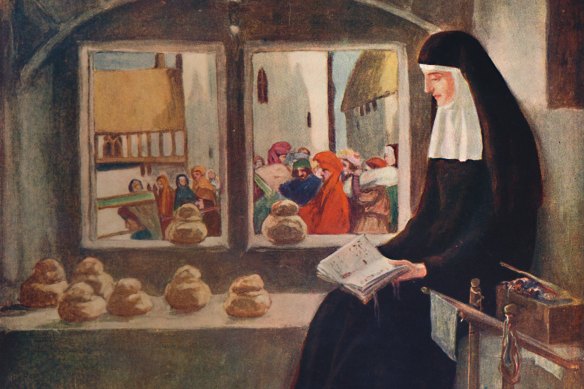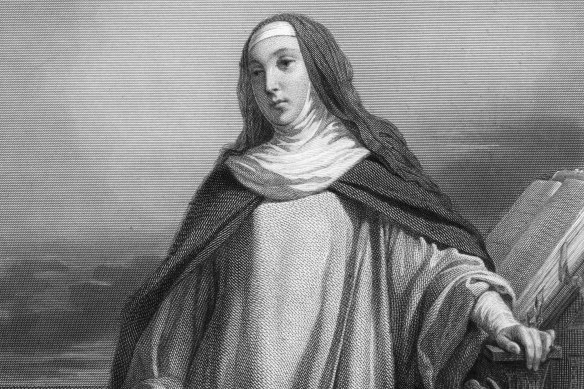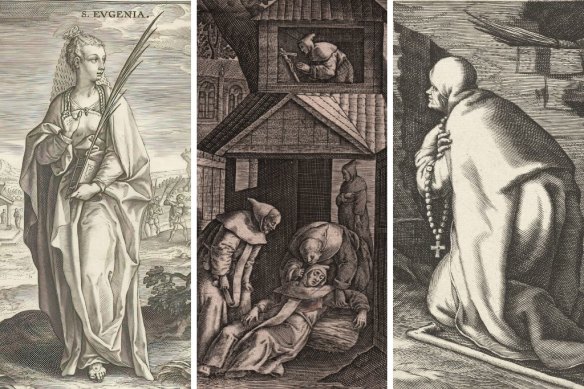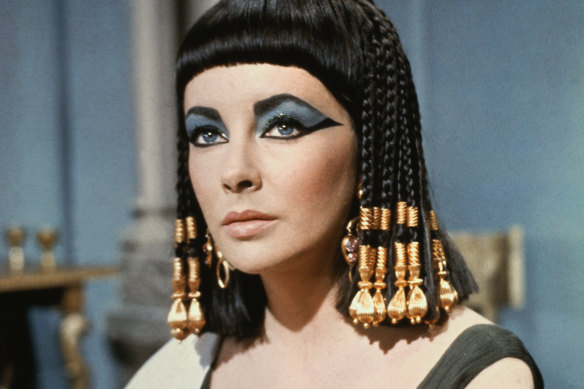
The quarrels of popes and kings, with wars or pestilences in every page; the men all so good for nothing, and hardly any women at all …”
Catherine Morland’s dismissal of history in Jane Austen’s Northanger Abbey kept popping into my mind as I researched my novel, Rapture, set in the 9th century.
Unlike poor Catherine, I had access to a diverse range of texts, the more recent featuring plenty of women who were left out of history books for centuries. Rapture’s heroine, Agnes, would have been astounded to find any women in her own books. The few that did appear would almost certainly be saints, their lives lessons in piety and (usually violent) martyrdom.
It’s not only that most medieval writers were men; it’s that, in Western Europe and Britain at least, they were mostly monks working under royal patronage. Their compositions tended to be chronicles of the times: quite literally the “quarrels of popes and kings”.

Emily Maguire: “Women and girls of the past did not only make up half of the population, they lived half of the stories.″Credit: Sarah Wilson
Compounding the problem, as Mary Wellesley writes in Hidden Hands: The Lives of Manuscripts and Their Makers (2021), the “vast majority of manuscripts produced in the medieval era” — by anyone, on anyone or anything — “perished through fire, flood, negligence or wilful destruction”.
“Whether forgotten, ignored or deliberately written out, it is a wonder that any female voices survive at all,” is how Janina Ramirez puts it in Femina (2023), her groundbreaking and celebratory history of medieval women.
There are some survivors. The Book of Margery Kempe is a medieval text in which the English Christian mystic and pilgrim looks back on her life and travels. Revelations of Divine Love by Julian of Norwich is one of the earliest surviving English-language books known to be written by a woman. Both of these against-all-odds survival tales are discussed in Hidden Hands and Femina. (The stories involve, respectively, a community of exiled nuns, and a ping-pong cupboard.)
Today, thanks to the painstaking work of historians, linguists, librarians, translators and others, the texts are widely available and accessible. Or as accessible as 600-year-old books of obscure religious mysticism could ever hope to be. That is, not very. Which is where the novelist comes in.
“If we want to meet the dead looking alive,” said Hilary Mantel, “we turn to art.” And turn we will, from the miraculously extant source documents, to Victoria MacKenzie’s 2023 novel, For Thy Great Pain Have Mercy on My Little Pain. MacKenzie’s novel is set in the beginning of the plague-haunted, politically turbulent 15th century, when Margery, a mother of 14, informs her husband that she’s now celibate, dresses herself in virginal white and wanders the town telling all and sundry about her intimate, carnal visions of Jesus.
The novel moves between Margery and Julian, a bereaved widow and mother on her sick bed, who experiences her own vivid “shewings” of the Passion of Christ. Soon after, she chooses to “die to the world” by being walled up as an anchoress.

Revelations of Divine Love by Julian of Norwich is one of the earliest surviving English-language books known to be written by a woman.Credit: Getty Images
Loading
Margery is loud, fleshy, agitated and agitating; Julian is still and quiet, her observations small and intricate. Through the novelist’s art, these long-ago voices are amplified and put into context, making them more comprehensible to a modern reader, yes, but also showing why it matters that these old books were written, rescued and reproduced in the first place. For many readers, meeting Margery and Julian as struggling, striving, fully rounded characters allows a connection to their messages of divine passion in a way the source texts alone could never do.
Margery and Julian lived towards the end of the medieval era. The further back we go, the tougher it is to find even traces of individual lives. Fortunately, as Ramirez writes, a dearth of individual biographies is less an obstacle than it once was, thanks to “developments in archaeology, advancements in technology and an openness to new angles ... While texts tend to favour the few, these approaches search for the many”.
Nicola Griffith’s novels, Hild (2013) and Menewood (2023), are excellent examples of how this (relatively) new understanding of “the many” can help novelists write into gaps in biographical records with imagination and authenticity.
The heroine of Griffith’s novels, 7th century abbess Hilda of Whitby, was important enough to rate inclusion in one of the foundational texts for English history, Bede’s Ecclesiastical History of the English. (Though Griffith notes that her entry focuses on the mostly male figures she advised or trained, including bishops, saints and monarchs.) This, and a mention in an 8th century calendar of saints, is all that remains of Hilda’s life story, but in Hild and Menewood, Griffith spins these sparse threads into a magnificent two-part epic (a third is promised).

Hilda of Whitby takes centre stage in Nicola Griffith’s novels.Credit: Getty Images
One of the thrilling things about these novels is that Griffith embeds her undeniably singular character in a society as peopled with women and girls as with men and boys, and those women and girls are doing all the things that we now know, thanks to historians, they have always done: birthing and weaving and cooking, yes, but also loving and fighting, following and leading, talking and thinking about God and nature and work and war. In doing so, these novels begin to gloriously correct centuries of depictions of medieval Britain as a hard, grey world of men with a few convenient women servicing them between battles.
Even fictional portrayals of the one place we’ve long been able to find medieval women — the convent — have benefited from this surge in interest in women’s lives. In Matrix (2021), Lauren Groff takes the scant known facts about 12th century poet Marie de France (multilingual, highly educated, had a relationship to a royal court and an interest in female power and desire), laces them with equally scant facts about Mary, Abbess of Shaftesbury (who some theorise was, indeed, the poet Marie de France), and brings forth a fictional Marie: reluctant nun turned radical leader of a self-sufficient community of women.
The idea for Matrix came to Groff while listening to a lecture by historian Katie Bugyis whose subject was not Marie de France or any single, notable figure but Benedictine nuns in the central Middle Ages. Groff’s “brain exploded into rainbows” on hearing the details of these lives; Bugyis later agreed to act as a historical consultant on Groff’s novel.
So while Matrix takes liberties, as it must, with the central character’s biography, the richness and complexity of the depiction of her community of women — the kind of community studied and written about by Bugyis — thrums with authenticity.
In my own novel, young Agnes does eventually find a few women from history to emulate. These women — Eugenia, Euphrosyne, Pelagia — were sainted for donning male disguises to enter monasteries and spend their lives in religious service. To Agnes, it does not matter that these stories have likely been fictionalised, at least in the hagiographic form in which they are told to her; it matters that they show her a path she did not know existed. The path creates the possibility that she may follow, yes, but also that if those women could carve their own road, then perhaps she might as well.

From left, Saints Eugenia, Euphrosyne and Pelagia inspire the central character in Emily Maguire’s Rapture.Credit: Alamy, Getty
This is why it matters, this rediscovering, reimagining, refocusing (apart from giving us some absolutely cracking reads — a noble pursuit in and of itself). As Ramirez writes: “Finding empowered women with agency from the medieval period is my way of … providing new narratives for readers today.”
This is not fantasy. Women and girls of the past did not only make up half of the population, they lived half of the stories. As long as historians keep digging up and piecing together the anonymous many, novelists can continue to conjure the individual dead, repave the newly uncovered paths and build a rousing, ongoing corrective to all those centuries of “men all so good for nothing, and hardly any women at all”.
Emily Maguire’s Rapture (Allen & Unwin, $32.99) is out now.
Forgotten chapters
A growing focus on the lives of women throughout history has introduced readers to some of the world’s most remarkable and previously unsung figures. Lindy Percival selects five of this year’s most surprising discoveries ...
The Instrumentalist (Bloomsbury): Harriet Constable’s bestselling debut novel imagines the life of Italian violinist and composer Anna Maria della Pietà, who was born c.1696 and was raised in an orphanage. Her musical prowess was discovered at the age of eight, and she went on to compose music and perform publicly for more than 60 years, becoming a protégé, and then rival, to Vivaldi in the process.
Saltblood (Bloomsbury): Francesca de Tores’ novel fills in official gaps in the life of cross-dressing pirate Mary Read, whose mother disguised her as a boy to maintain a family endowment after Mary’s older brother died. Maintaining the disguise, she served in the military before joining notorious pirate Jack Rackman on the high seas, along with her lover, Anne Bonny. The trio was arrested in October 1720 and she died in prison the following year.

Elizabeth Taylor in Cleopatra.Credit: Getty Images
The Cleopatras (Wildfire): Popular culture was besotted by Cleopatra long before Elizabeth Taylor took bat-winged eyeliner to a new level in the 1963 Hollywood classic. What filmgoers probably didn’t know was that the Egyptian queen was actually seventh in a line of powerful female rulers of the Ptolemaic Empire (305 BC–30 BC). Historian Lloyd Llewellyn-Jones corrects the record in this study of the ruthless and single-minded septet that put the patriarchy in its place.

Monte Punshon at 103.
A Secretive Century (MUP): Tessa Morris-Suzuki’s biography of Ethel May “Monte” Punshon (1882-1989) traces the life of the convention-flouting artist and teacher who was dubbed “the world’s oldest lesbian” when she came out at the age of 100. Punshon transcended a conservative Methodist background in Ballarat to embrace the Bohemian life in 1930s Melbourne. She developed a lifelong affinity with Japan while working in an internment camp during the war and was still teaching Japanese at 102. Three years before her death, at the age of 103, she joined MENSA.
Loading
In the Margins (Ultimo Press): Gail Holmes’ novel imagines the life of 17th century rector’s wife Frances Wolfreston, an avid reader who was the eldest of 22 children, and herself the mother of 10 or 11 children. Somehow, she found the time to amass an important collection of books, including the only surviving copy of the 1593 edition of Shakespeare’s Venus and Adonis, inscribed with her name. Today, books from her extraordinary collection can be found in libraries in Britain, Europe and the United States.
The best of Good Weekend delivered to your inbox every Saturday morning. Sign up here.









 Add Category
Add Category